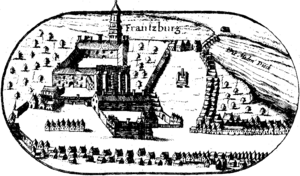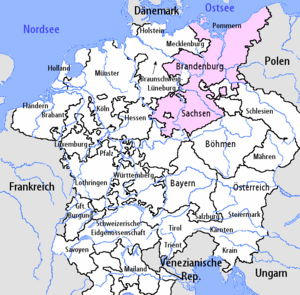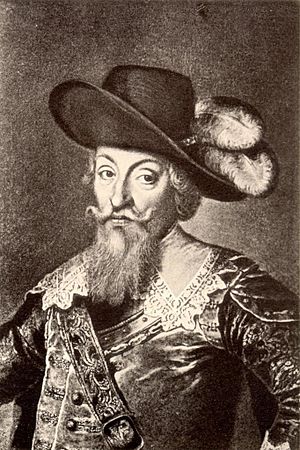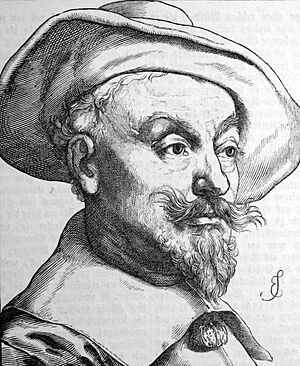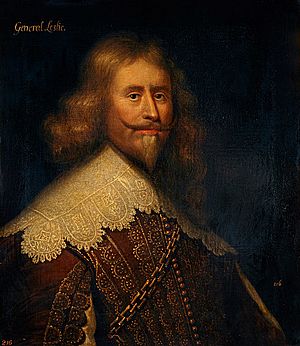Capitulation of Franzburg facts for kids
The Capitulation of Franzburg was an agreement signed on November 20, 1627. It meant that the Duchy of Pomerania had to surrender to the army of the Holy Roman Empire during the Thirty Years' War. The agreement was signed by Duke Bogislaw XIV, Duke of Pomerania and Hans Georg von Arnim, a general from Albrecht von Wallenstein's army.
The terms of this agreement were very hard for Pomerania. The occupying army often ignored the rules, making life even tougher for the people. The city of Stralsund bravely fought back with help from Denmark, Sweden, and Scotland. Another attempt by Denmark to intervene failed. The imperial army stayed in Pomerania until Swedish forces arrived in 1630. The Swedes then pushed the imperial troops out of Pomerania by 1631.
Why it Happened
Pomerania became a Protestant region in 1534. The Thirty Years' War began in 1618. It was mainly a fight between Catholic and Protestant groups. Ferdinand II, Holy Roman Emperor and the Catholic League fought against Protestant nobles and states.
Pomerania was part of the Protestant Upper Saxon Circle. This group included powerful regions like Saxony and Brandenburg. They had declared themselves neutral in 1620. But the Catholic League was winning. Saxony joined the emperor's side in 1624. Brandenburg and Pomerania tried to stay neutral but faced demands from the emperor. They even turned down an offer to ally with Protestant Denmark.
In 1625, imperial forces led by Albrecht von Wallenstein took over some areas near Pomerania. These troops were meant to help the Catholic League. Danish forces then occupied some Brandenburg regions in 1625. But they were defeated by Wallenstein's army in 1626. After Denmark was weakened, imperial forces occupied and damaged many Protestant states. These states, including Pomerania, did not have strong armies to defend themselves.
In November 1626, Sweden started recruiting soldiers in Pomerania. Duke Bogislaw XIV did not approve. In February 1627, Swedish troops marched through Pomerania to reach Poland, which was an ally of the emperor. In July, imperial troops entered Pomerania. To avoid a full takeover, Duke Bogislaw offered money. But Albrecht von Wallenstein ignored him. Instead, he ordered his general, Hans-Georg von Arnim, to take over all Pomeranian ports and ships.
The occupation of Pomerania was a smart military move. It was not just punishment. The empire wanted to control the southern coast of the Baltic Sea. This was to protect against Christian IV of Denmark, whose army was fighting on imperial land. The empire could not challenge Denmark's strong navy in the Baltic Sea.
What the Treaty Said
The treaty set the rules for how imperial troops would be housed, also called "billeting." Some sources say Duke Bogislaw agreed to house eight or ten regiments. But in reality, about 31,000 foot soldiers and 7,540 cavalry were counted. This number does not even include all the military staff and their families.
Generally, all towns and villages had to house the soldiers. But some places were exempt. These included specific lands of the House of Pomerania, estates of knights, and homes of clergy, advisors, and scholars. The duke's own homes in Damm, Köslin, Stettin, and Wolgast were also exempt.
The duchy also had to pay money to the imperial forces. They had to pay 407 Reichstalers per company each week. An extra 2,580 Reichstalers were paid for the staff.
How it Affected People
Towns like Anklam, Demmin, Greifswald, and Kolberg became homes for garrisons (large groups of soldiers). Smaller units were placed in other towns. Cavalry (soldiers on horseback) often stayed in villages. This was because it was easier to care for horses there. Also, fewer cavalry soldiers ran away compared to foot soldiers.
Even though the treaty didn't say it directly, housing soldiers followed common rules. Homeowners had to give soldiers a bed, vinegar, and salt. They also had to share their kitchen and a warm living room for free. In theory, soldiers were supposed to pay for their food. They could pay their hosts or buy food from special military stores.
Albrecht von Wallenstein had promised the emperor he would pay for his army himself. But in reality, the army was paid and fed by the occupied lands. Soldiers often took what they needed from the local people. This was because their commanders often kept the money meant for the lower ranks. This practice was called "bellum se ipsum alet," meaning "war feeds itself."
Life became very hard for the people of Pomerania. Besides the soldiers not following the rules, there were more diseases. These epidemics spread easily because so many soldiers were living in close quarters. Natural resources also started to run out. By May 1628, Pomerania had already paid 466,981 Reichstalers. This was twice what the entire Upper Saxon Circle produced in a year. The suffering in Pomerania was terrible and became famous.
Stralsund was the only city in Pomerania to fight back against the imperial occupation. This led to the Battle of Stralsund (1628). Stralsund had been an independent Hanseatic town for a long time. It refused to follow the duke's order to accept the capitulation. Instead, it asked Denmark and Sweden for help. Both countries sent aid. Christian IV of Denmark sent Scottish soldiers. Scottish officers Alexander Seaton and Alexander Leslie led the defense. Wallenstein tried to capture the city. But in July 1628, his attacks failed. Stralsund became his first big defeat in the war. He lifted the siege to fight Christian IV of Denmark near Wolgast. Christian IV had already destroyed Wallenstein's naval bases. He wanted to secure another port in Pomerania. But he was completely defeated and went back to Denmark.
Stralsund then made an alliance with Gustavus Adolphus of Sweden. This gave Sweden a base on imperial land. It also marked Sweden's entry into the Thirty Years' War.
In February 1629, Duke Bogislaw XIV tried to ease the occupation. Ferdinand II promised to help but did nothing. Instead, the emperor issued the Edict of Restitution in March. This order aimed to make Protestant states Catholic again. The Treaty of Lübeck in May ended the fighting between Denmark and the emperor. But it did not end the occupation of Pomerania.
In September 1629, France helped Sweden and Poland-Lithuania agree to a truce. This meant Sweden was ready to invade the Holy Roman Empire. The invasion began in the spring of 1630 when Gustavus Adolphus's troops landed on Usedom island. At the same time, attacks on Rügen and the nearby mainland by the Stralsund army protected his side. Because of this, the Capitulation of Franzburg was replaced. Pomerania and Sweden formed an alliance, confirmed in the Treaty of Stettin (1630).
What Happened Later
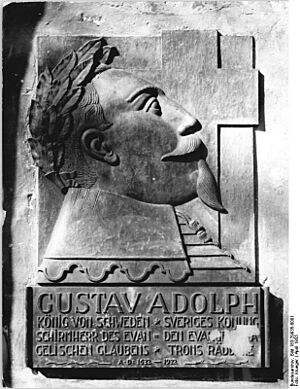
The Capitulation of Franzburg marked the start of the Thirty Years' War in Pomerania. The terrible suffering it caused was just a sign of what was to come. By the end of the war, two-thirds of Pomerania's people had died.
Stralsund's successful resistance gave Sweden a foothold in the Holy Roman Empire. This was especially important after Denmark left the war. The Swedish army in Stralsund was the first on German soil in history. Sweden's parliament had approved plans to intervene in 1627. In 1629, they approved an offensive war. Swedish forces invaded Pomerania in 1630. By June 1631, they had taken the last imperial stronghold, Greifswald. Sweden kept this land, known as Swedish Pomerania, until 1815.
Duke Bogislaw XIV had just become the sole ruler of Pomerania in 1625. After the Swedish takeover, he wrote a paper called "Three Years of Distress." He said the Capitulation of Franzburg had been forced on him. At the same time, he wrote to the emperor. He apologized for allying with Sweden, saying he had no choice. He even included a part in the Treaty of Stettin (1630) that said the alliance was for the empire's good. Bogislaw died in 1637 without children. This ended about 500 years of rule by the House of Pomerania.
The town of Franzburg, where the treaty was signed, was also destroyed by the war. In 1670, only 70 people lived there. Franzburg was not settled again until 1728.
See also
 In Spanish: Capitulación de Franzburgo para niños
In Spanish: Capitulación de Franzburgo para niños
- Pomerania during the Early Modern Age
- Thirty Years' War
- Battle of Stralsund (1628)
- Battle of Wolgast
- Duchy of Pomerania
- Swedish Pomerania
|


